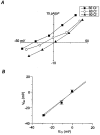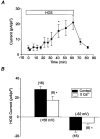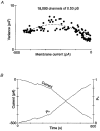Hyposmotically activated chloride channels in cultured rabbit non-pigmented ciliary epithelial cells
- PMID: 10562334
- PMCID: PMC2269649
- DOI: 10.1111/j.1469-7793.1999.00057.x
Hyposmotically activated chloride channels in cultured rabbit non-pigmented ciliary epithelial cells
Abstract
1. We used whole-cell patch-clamp recording techniques and noise analysis of whole-cell current to investigate the properties of hyposmotic shock (HOS)-activated Cl- channels in SV40-transformed rabbit non-pigmented ciliary epithelial (NPCE) cells. 2. Under conditions designed to isolate Cl- currents, exposure of cells to hyposmotic external solution reversibly increased the whole-cell conductance. 3. The whole-cell current activated with a slow time course (> 15 min), exhibited outward rectification and was Cl- selective. 4. The disulphonic stilbene derivatives 4, 4'-diisothiocyanatostilbene-2,2'-disulfonic acid (DIDS, 0.5 mM), 4-acetamido-4'-isothiocyanatostilbene-2,2'-disulfonic acid (SITS, 0. 5 mM) and 4,4'-dinitrostilbene-2,2'-disulfonic acid (DNDS, 0.5 mM) produced a voltage-sensitive block of HOS-activated Cl- current at depolarized potentials, whereas niflumic acid produced a voltage-independent block of the current. 5. Under Ca2+-free conditions, HOS stimulation still reversibly activated the Cl- current, but the amplitude of current was reduced and the time course of current activation was slower compared with control (P < 0. 05). 6. The non-specific kinase inhibitor H-7 (100 microM), upregulated HOS-activated Cl- current amplitude in all cells tested (P < 0.05). 7. Noise analysis of whole-cell Cl- current indicated that cell swelling activated a high density of small conductance Cl- channels (< 1 pS). 8. We conclude that HOS primarily activates a high density of volume-sensitive small conductance Cl- channels in rabbit NPCE cells, and that Ca2+ and phosphorylation are involved in channel regulation.
Figures






Similar articles
-
Outwardly rectifying chloride current in rabbit osteoclasts is activated by hyposmotic stimulation.J Physiol. 1994 Mar 15;475(3):377-89. doi: 10.1113/jphysiol.1994.sp020079. J Physiol. 1994. PMID: 8006823 Free PMC article.
-
P-glycoprotein regulates a volume-activated chloride current in bovine non-pigmented ciliary epithelial cells.J Physiol. 1996 Mar 15;491 ( Pt 3)(Pt 3):743-55. doi: 10.1113/jphysiol.1996.sp021254. J Physiol. 1996. PMID: 8815208 Free PMC article.
-
A large-conductance chloride channel in pigmented ciliary epithelial cells activated by GTPgammaS.J Membr Biol. 1997 Jul 15;158(2):167-75. doi: 10.1007/s002329900254. J Membr Biol. 1997. PMID: 9230094
-
Aspects of calcium-activated chloride currents: a neuronal perspective.Pharmacol Ther. 1995 Jun;66(3):535-65. doi: 10.1016/0163-7258(95)00018-c. Pharmacol Ther. 1995. PMID: 7494858 Review.
-
Volume-sensitive chloride channels involved in apoptotic volume decrease and cell death.J Membr Biol. 2006 Jan;209(1):21-9. doi: 10.1007/s00232-005-0836-6. Epub 2006 Apr 17. J Membr Biol. 2006. PMID: 16685598 Review.
Cited by
-
P2X4 activation modulates volume-sensitive outwardly rectifying chloride channels in rat hepatoma cells.J Biol Chem. 2010 Mar 5;285(10):7566-74. doi: 10.1074/jbc.M109.063693. Epub 2010 Jan 7. J Biol Chem. 2010. PMID: 20056605 Free PMC article.
-
A3 adenosine and CB1 receptors activate a PKC-sensitive Cl- current in human nonpigmented ciliary epithelial cells via a G beta gamma-coupled MAPK signaling pathway.Br J Pharmacol. 2003 Jun;139(3):475-86. doi: 10.1038/sj.bjp.0705266. Br J Pharmacol. 2003. PMID: 12788807 Free PMC article.
References
-
- Adorante JS, Cala PM. Mechanisms of regulatory decrease in nonpigmented human ciliary epithelial cells. American Journal of Physiology. 1995;268:C721–731. - PubMed
-
- Botchkin LM, Matthews G. Chloride current activated by swelling in retinal pigment epithelial cells. American Journal of Physiology. 1993;265:C1037–1045. - PubMed
-
- Botchkin LM, Matthews G. Swelling activates chloride current and increases internal calcium in nonpigmented epithelial cells from rabbit ciliary body. Journal of Cell Physiology. 1995;164:286–294. - PubMed
MeSH terms
Substances
LinkOut - more resources
Full Text Sources
Miscellaneous

